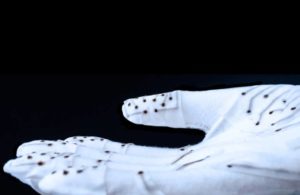
An MIT team of engineers has designed a new touch-sensing glove that can “feel” pressure and other tactile stimuli. The glove’s inside lining is studded with small, kernel-sized electrodes that can sense and map subtle changes in pressure.
[Image courtesy of the researchers]
Engineers at MIT are touting a new, touch-sensing glove that can “feel” pressure and other tactile stimuli.
The researchers developed a way to precisely measure and map subtleties of tactile dexterity through the glove. The inside of the glove is threaded with sensors that detect, measure and map small changes in pressure across the glove. The individual sensors are highly attuned and can pick up weak vibrations across the skin, like from a person’s pulse.
According to a news story posted on MIT’s website, the researchers believe the tactile glove could help to retrain motor function and coordination in people who have suffered a stroke or other fine motor condition. The team also envisions the integration of the pressure sensors beyond the gloves and into flexible adhesives to track pulse, blood pressure and other vital signs more accurately than smartwatches and other wearable monitors.
“The simplicity and reliability of our sensing structure holds great promise for a diversity of health care applications, such as pulse detection and recovering the sensory capability in patients with tactile dysfunction,” MIT mechanical engineering professor Nicholas Fang said in the story.
Fang and co-authors Huifeng Du and Liu Wang at MIT, along with a group under Chuanfei Guo at the Southern University of Science and Technology in China, had their study results published in Nature Communications.
The groups developed the gloves pressure sensors in a manner similar in principle to sensors found in HVAC systems that measure humidity. These small capacitors with two electrodes or metal plates sandwich a rubbery “dielectric” material that shuttles electric charges between the electrodes.
In humid conditions, the dielectric layer acts as a sponge to soak up charged ions from surrounding moisture, the researchers say, with the addition of ions changing the capacitance in a way that can be quantified and converted to a measurement of humidity. The MIT and SUSTech team avoided the conventional dielectric layer to utilize human sweat instead, with ions such as sodium and chloride serving as dielectric stand-ins.
By covering the underside of the electrode with a “forest” of tiny, bendy, conductive hairs, it allows for the hairs in a specific region receiving pressure to bend and accumulate ions from the skin, with the degree and location measurable and mappable.
The new study used a silk glove purchased off the shelf, with small squares from a carbon cloth used to make pressure sensors. Each square was turned into a sensing electrode when the researchers sprayed them with gold, a naturally conductive metal. Volunteers took turns using the glove to perform tasks such as holding a balloon and gripping a glass beaker, with readings collected from each sensor to create a pressure map across the glove.
Using the glove to identify pressure patterns for other tasks, like writing with a pen and handling other household objects, could help patients with motor dysfunction to calibrate and strengthen their hand dexterity and grip, the researchers say.
“Some fine motor skills require not only knowing how to handle objects, but also how much force should be exerted,” Fang said. “This glove could provide us more accurate measurements of gripping force for control groups versus patients recovering from stroke or other neurological conditions. This could increase our understanding, and enable control.”